Comparative Analysis of the Level of Satisfaction with the Services Received at the Business Incubators (Hazleton, PA, USA and Gliwice, Poland)
Abstract
1. Introduction
2. Literature Review
- expanding an incubator’s function,
- successfully connecting to venture capital,
- forging an optimal path from pre-starting companies towards gazelle creation,
- increasing clients outside the incubator walls, and
- successfully using the internationalization processes for stronger results.
- the lack of financial resources available to incubators,
- the challenge of finding qualified people to staff incubators,
- the lack of partnering opportunities outside the incubator organization because professional services are often scare and focused on large companies,
- the mindset of entrepreneurs often makes them unwilling to give up equity in their companies,
- entrepreneurs may be less willing to trust outsiders,
- the general business environment may be less favorable,
- the propriety rights situation may be less developed,
- some national cultures may be more risk-averse, and
- the lack of venture capital and networks of investors.
3. Methodology of Assessment and Data Collection
- N-sample size,
- mean value,
- standard deviation,
- significance (sign): 2-tailed sign,
- T-test for equality of means, and
- standard error mean.
4. Analysis of the Level of Satisfaction with the Services Received at the Business Incubators in Hazleton PA, USA and Gliwice, Poland
- office space / secretarial support,
- manufacturing space / warehouse,
- consulting service from volunteers,
- consulting services from faculty and students,
- help from students cooperating with the company in the form of capstone design projects,
- assistance from personal of business incubator center,
- legal assistance in protecting intellectual propriety (patent),
- assistance in creating a website for a company,
- legal assistance in establishing and registering corporation,
- legal assistance in accounting and filling income tax,
- assistance in marketing of the product,
- legal assistance in securing tax-free status during the incubation stage,
- assistance in professional development and training, and
- legal help in obtaining financial subsidies for creating new jobs.
- assistance in creating internet websites for the companies,
- legal assistance in establishing or registering a corporation,
- legal assistance in accounting and filing taxes,
- legal assistance in obtaining financial subsidies for creating new jobs (there are limited subsidies for creating new jobs in Poland),
- legal assistance in securing tax-free status during the incubation stage (there is no tax-free status for start-up companies during the incubation stage in Poland), and
- legal assistance in protecting intellectual property.
- assistance provided by volunteer consultants,
- assistance from students doing capstone design projects,
- legal assistance in securing tax-free status,
- legal assistance in applying for financial support in creating new jobs (there is very limited financial support for creating new jobs in Poland),
- assistance in developing marketing strategies and internet sales,
- legal assistance in protecting intellectual property (applying for patent),
- engineering assistance in improving innovation, and
- assistance in establishing a continuous quality improvement process.
- to increase the number of students and faculty providing services to the companies (9.9),
- to increase the financial benefits for creating new jobs (10),
- to increase legal help in protecting intellectual property (9),
- to increase the number of volunteers (9), and
- to increase engineering assistance (9).
- tax free status (CAN-BE already has it (0),
- improve business management assistance (6).
- to incorporate tax-free status for new companies (8),
- to increase financial benefits for creating new jobs (7.67),
- to increase help in business management and accounting (7.67),
- to increase engineering help (7.33), and
- to improve legal assistance (intellectual property, taxes, etc.) (6.33).
- increase number of volunteers (2.0),
- increase number of faculty (2.33), and
- increase number of students (2.33).
- “Office and manufacturing space”
- “Close proximity to the university”
- “Lower than market value rent for office space”
- “Help with professional market analysis”
- “Networking meetings”
- “All forms of assistance was very helpful”
- “More networking meetings”
- “Faculty from Silesian University of Technology should be more involved and provide their expertise to the client companies on an ongoing basis”
- “They should be more involved in individual projects”
- “Students and faculty from Penn State Hazleton”
- “Assistance provided by volunteers”
- “Low cost of office and manufacturing space”
- “Help with market analysis”
- “Convenient location”
- “Modern facilities”
- “Increased opportunity for commercial loans”
- “More networking”
- “More professional training”
- self-satisfaction (7.08–8.50),
- gaining professional experience (6.16–8.68), and
- establishing professional contacts (6.66–8.56).
- additional income (2.31–4.90) and
- obtaining full-time employment (3.25–4.33).
- CAN-BE: CBI = 9.25 (92.5% satisfaction)
- TECHNOPARK: CBI = 6.83 (68.3% satisfaction)
- CAN-BE: CI = 7.186 (71.86% satisfaction)
- TECHNOPARK: CI = 2.357 (23.57% satisfaction)
- CAN-BE: CPI = 7.62 (76.2% satisfaction)
- TECHNOPARK: CPI = 1.63 (16.3% satisfaction)
5. Conclusions
- to increase the number of students and faculty providing services to the companies,
- to increase the financial benefits for creating new jobs,
- to increase legal help in protecting intellectual property,
- to increase the number of volunteers, and
- to increase engineering assistance.
- to incorporate tax-free status for new companies,
- to increase financial benefits for creating new jobs,
- to increase help in business management and accounting,
- to increase engineering help, and
- to improve legal assistance (intellectual property, taxes, etc.).
Author Contributions
Funding
Conflicts of Interest
References
- Abetti, P.A. Government-Supported Incubators in the Helsinki Region, Finland: Infrastructure, Results, and Best Practices. J. Technol. Transf. 2004, 29, 19–40. [Google Scholar] [CrossRef]
- Akçomak, I.S. Incubators as Tools for Entrepreneurship Promotion in Developing Countries. In Entrepreneurship, Innovation and Economic Development; Szirmai, A., Naude, W., Goedhuys, M., Eds.; Oxford University Press: Oxford, UK, 2011; pp. 228–264. [Google Scholar]
- Allen, D.N.; Rahman, S. Small Business Incubators: A Positive Environment for Entrepreneurship. J. Small Bus. Manag. 1985, 23, 12–22. [Google Scholar]
- Al-Mubaraki, H.M.; Muhammad, A.H.; Busler, M. Innovation and Entrepreneurship: Powerful Tools for a Modern Knowledge-Based Economy; Springer International Publishing: New York, NY, USA, 2015. [Google Scholar]
- Carter, C.R.; Rogers, D.S. A framework of sustainable supply chain management: Moving toward new theory. Int. J. Phys. Distrib. Logist. Manag. 2008, 38, 360–387. [Google Scholar] [CrossRef]
- Fry, F.L. The Role of Incubators in Small Business Planning. Am. J. Small Bus. 1987, 12, 51–62. [Google Scholar] [CrossRef]
- Gullander, S. Incubation as a Tool to Encourage Scientific Entrrepreunership in Europe; Best Practices in Science-based Incubators: Seville, Spain, 2007. [Google Scholar]
- Hendricks, B.; Singhal, V.R. Effect of supply chain disruptions on long-run stock price performance and equity risk of the firm. Prod. Oper. Manag. 2005, 14, 35–52. [Google Scholar] [CrossRef]
- Hsu, P.H.; Shyu, J.Z.; Yu, H.C.; You, C.C.; Lo, T.S. Exploring theInteraction between Incubators and Industrial Clusters: The Case of the ITRI Incubator in Taiwan. R D Manag. 2003, 33, 79–90. [Google Scholar] [CrossRef]
- Hurley, K. The First Incubator Business: Incubator Building. Econ. Dev. J. 2002, spring, 53–56. [Google Scholar]
- Jacobs, B.; Singhal, V.R. The effect of product development restructuring on shareholder value. Prod. Oper. Manag. 2013, 23, 728–743. [Google Scholar]
- Lee, S.S.; Osteryoung, J.S. A Comparison of Critical Success Factors for Effective Operations of University Business Incubators in the United States and Korea. J. Small Bus. Manag. 2004, 42, 418–426. [Google Scholar] [CrossRef]
- Lin, D.; Wood, L.C.; Lu, Q. Improving business incubator service performance in China: The role of networking resources and capabilities. Serv. Ind. J. 2012, 32, 2091–2114. [Google Scholar] [CrossRef]
- McAdam, M.; Marlow, S. Building Futures or Stealing Secrets?: Entrepreneurial Cooperation and Conflict within Business Incubators. Int. Small Bus. J. 2007, 25, 361–382. [Google Scholar] [CrossRef]
- Moiseeva, N.K.; Smirnova, J.; Infante, D. Russian high-tech business incubators: Functional-and-value analysis approach. Int. J. Econ. Bus. Res. 2014, 8, 193–204. [Google Scholar] [CrossRef]
- De Montigny, N. Dynamic Canadian Bio-Incubation. Paper presented at the 6th Annual Conference on Science Based Incubation “Best Practices in Science Based Incubators—Expanding the incubator’s function”, Seville, Spain, 29–30 November 2007. [Google Scholar]
- Pena, I. Business Incubation Centers and New Firm Growth in the Basque Country. Small Bus. Econ. 2004, 22, 223–236. [Google Scholar] [CrossRef]
- Peters, L.; Rice, M.; Sundararajan, M. The role of incubators in the entrepreneurial process. J. Technol. Transf. 2004, 29, 83–91. [Google Scholar] [CrossRef]
- Scaramuzzi, E. Incubators in Developing Countries: Status and Development Perspectives, infoDev Program; The World Bank: Washington, DC, USA, 2002. [Google Scholar]
- Stefanović, G.; Devedžić, G.; Eric, M. Incubators in Developing Countries: Development Perspectives. Int. J. Qual. Res. 2008, 2, 157–163. [Google Scholar]
- Studdard, N.L. The Effectiveness of Entrepreneurial Firm’s Knowledge Acquisition from a Business Incubator. Int. Entrep. Manag. J. 2006, 2, 211–225. [Google Scholar] [CrossRef]
- Tang, M.F.; Lee, J.; Liu, K.; Lu, Y. Assessing government-supported technology-based business incubators: Evidence from China. Int. J. Technol. Manag. 2014, 65, 24–48. [Google Scholar] [CrossRef]
- Salem, M.I. The Role of Business Incubators in The Economic Development of Saudi Arabia. Int. Bus. Econ. Res. J. 2014, 13, 853–859. [Google Scholar] [CrossRef]
- Von Zedtwitz, M.; Grimaldi, R. Are Service Profiles Incubator-Specific? Results from an Empirical Investigation in Italy. J. Technol. Transf. 2006, 31, 459–468. [Google Scholar] [CrossRef]
- Wynarczyk, P.; Raine, A. The Performance of Business Incubators and Their Potential Development in the North East Region of England. Local Econ. 2005, 20, 205–220. [Google Scholar] [CrossRef]
- Hackett, S.M.; Dilts, D.N. A systematic review of business incubation research. J. Technol. Transf. 2004, 29, 55–82. [Google Scholar] [CrossRef]
- Priscilla, A.G. Fundamentals of Survey Research Methodology. Available online: https://www.mitre.org/sites/default/files/pdf/05_0638.pdf (accessed on 8 January 2018).
- Wolniak, R.; Grebski, M.E. Comparative analysis of the level of satisfaction with the services received at the Business Incubators in USA and Poland—Pre-incubation and incubation stage. Prod. Eng. Arch. 2017, 18, 1–6. [Google Scholar] [CrossRef]
- Xiao, L.; North, D. The graduation performance of technology business incubators in China’s three tier cities: The role of incubator funding, technical support, and entrepreneurial mentoring. J. Technol. Transf. 2016, 42, 615–634. [Google Scholar] [CrossRef]
- Mian, S.A. Are University Technology Incubators Providing a Milieu For Technology-Based Entrepreneurship? Technol. Manag. 1994, 1, 86–93. [Google Scholar]
- Bruneel, J.; Ratinho, T.; Clarysse, B.; Groen, A. The Evolution of Business Incubators: Comparing demand and supply of business incubation services across different incubator generations. Technovation 2012, 32, 110–121. [Google Scholar] [CrossRef]
- European Commission. Benchmarking of Business Incubators: Final Report; Centre for Strategy & Evaluation: Sevenoaks, UK, 2002. [Google Scholar]
- Mas-Verdu, F.; Ribeiro-Soriano, D.; Roig-Tierno, N. Firm survival: The role of incubators and business characteristics. J. Bus. Res. 2015, 68, 793–796. [Google Scholar] [CrossRef]
- Zasadzień, M.; Zarnovsky, J. Improvement of selected logistics processes using quality engineering tools. Manage. Syst. Prod. Eng. 2018, 26, 55–59. [Google Scholar]
- Technopark Gliwice. Available online: https://technopark.gliwice.pl/oferta/ (accessed on 9 January 2018).
- Al-Mubaraki, H.; Busler, M. The importance of business incubation in developing countries: Case study approach. Int. J. Foresight Innov. Policy 2015, 10, 17–28. [Google Scholar] [CrossRef]
- Al-Mubaraki, H.M.; Busler, M. The Incubators Economic Indicators. Mixed Approaches. J. Case Res. Bus. Econ. 2012, 4, 1–12. [Google Scholar]
- TARGIT: Business Incubators. All New TARGIT for 2017. Available online: https://www.targit.com/en/meet-targit/targit-news/news-list/2016/10/decision-suite-2017 (accessed on 9 January 2018).
- Albort-Morant, G.; Ribeiro-Soriano, D. A bibliometric analysis of international impact of business incubators. J. Bus. Reserach 2016, 69, 1775–1779. [Google Scholar] [CrossRef]
- Roig-Tierno, N.; Alcazar, J.; Ribeiro-Navarrete, S. Use of infrastructures to support innovative entrepreneurship and business growth. J. Bus. Res. 2015, 68, 2290–2294. [Google Scholar] [CrossRef]
- Anderson, B.B.; Al-Mubaraki, H. The Gateway Innovation Center: Exploring Key Elements of Developing a Business Incubator. World J. Entrep. Manag. Sustain. Dev. 2012, 8, 208–216. [Google Scholar] [CrossRef]
- Schwartz, M. A control group study of incubator’s impact to promote firm survival. J. Technol. Transf. 2013, 38, 302–331. [Google Scholar] [CrossRef]
- Bergek, A.; Norrman, C. Incubator best practice: A framework. Technovation 2008, 28, 20–28. [Google Scholar] [CrossRef]
- Wang, C.-N.; Li, K.-Z. A candidates selection approach for district alliance of university incubators. Qual. Quant 2011, 45, 769–781. [Google Scholar] [CrossRef]
- Chiara, C. A service incubator business model: External networking orientation. IMP J. 2014, 3, 237–285. [Google Scholar]
- Economic Commission for Europe: Best Practices in Business Incubation—UKSPA; United Nations: Geneva, Switzerland; New York, NY, USA, 2001.
- European Commission. The Smart Guide to Innovation-Based Incubators (IBI); Publications Office of the European Union: Luxembourg, 2010. [Google Scholar]
- Eveleens, C.P.; van Rijnsoever, F.J.; Niesten, E.M.M.I. How network-based incubation helps start-up performance: A systematic review against the background of management theories. J. Technol. Transf. 2016, 42, 676–713. [Google Scholar] [CrossRef]
- Löfsten, H. Organisational capabilities and the long-term survival of new technology-based firms. Eur. Bus. Rev. 2016, 28, 312–332. [Google Scholar] [CrossRef]
- Lewis, D.A. Does Technology Incubation Work? A Critical Review; NBIA Publications: Athencs, OH, USA, 2002. [Google Scholar]
- Vanderstraeten, J.; Matthyssen, P.; Witteloostuijn, A. Measuring the Performance of Business Incubators; University of Antwerp: Antwerpen, Belgium, 2012. [Google Scholar]
- Obaji, N.O.; Onyemerela, Ch.; Olugu, M.U. Entrepreneurship and business incubation programme: The sure couple. Int. J. Sci. Technol. Manag. 2015, 4, 1627–1633. [Google Scholar]
- Deloitte Consulting: Business Incubator Model. Business Road Map 2020. 2017. Available online: http://www/macro-project.net/cms/uploads/bi_model_030712_for-edc.pdf (accessed on 9 January 2018).
- Lasrado, V.; Sivo, S.; Ford, C.; O’Neal, T.; Garibay, I. Do graduated university incubator firms benefit from their relationship with university incubators? J. Technol. Transf. 2016, 41, 205–219. [Google Scholar] [CrossRef]
- Strategy Center: Business Incubator Prices. 2017. Available online: http://www.strategycenterok.com/business-incubator-center (accessed on 9 January 2018).
- Hernándeza, R.; Carrà, G. A conceptual approach for business incubator interdependenciesand sustainabledevelopment. Agric. Agric. Sci. Procedia 2016, 8, 718–724. [Google Scholar]
- Caiazza, R. Benchmarking of Business Incubators. Benchmarking Int. J. 2014, 21, 1062–1069. [Google Scholar] [CrossRef]
- Olkiewicz, M.; Wolniak, R.; Grebski, E.; Olkiewicz, A. Comparative analysis of the impact of the business incubator center on the economic sustainable development of regions in USA and Poland. Sustainability 2019, 11, 173. [Google Scholar] [CrossRef]
- Mian, S.A.; Lamine, W.; Fayolle, A. Technology business incubation: An overview of the state of knowledge. Technovation 2016, 50–51, 1–12. [Google Scholar] [CrossRef]
- Totterman, H.; Sten, J. Start-ups: Business Incubation and Social Capital. Int. J. Small Bus. 2005, 23, 487–511. [Google Scholar] [CrossRef]
- Northeastern Pennsylvania Alliance: 2013–2018 Comprehensive Economic Development Strategy Five Year Plan for Northeastern Pennsylvania. Available online: http://www.nepa-alliance.org/wp-content/uploads/CEDS-2013-Five-Year-Plan.pdf (accessed on 8 January 2018).
- Northeastern Pennsylvania Alliance: 2015–2016 Comprehensive Economic Development Strategy. Annual Performance Report for Northeastern Pennsylvania. Available online: http://www.nepa-alliance.org/wp-content/uploads/CEDS-2015-2016-Annual-Performance-Report.pdf (accessed on 8 January 2018).
- Embassy of Poland: Trade and Investment Section of the Embassy of Poland; Polish American Chamber of Commerce: Washington, DC, USA; Chicago, IL, USA, 2012.
- Frick, W. The U.S. startup economy is in both better and worse shape than we thought. Harv. Buisness Rev. 2016, 11, 2–5. [Google Scholar]
- Ponto, J. Understanding and evaluating survey research. J. Adv. Pract. Oncol. 2015, 6, 168–171. [Google Scholar]
- Punch, K. Introduction to Social Research. Quantitative and Qualitative Approaches; Sage: London, UK, 1988. [Google Scholar]
- Stebbins, R.A. Exploratory Research in Social Science; Sage: Thousand Oaks, CA, USA, 2001. [Google Scholar]
- Zechmeister, E.; Jeanne, Z. Research Methods in Psychology; Mc Graw Hill: New York, NY, USA, 2011; pp. 161–175. [Google Scholar]
- Ziman, J. Real Science: What is, and What it Means; Cambridge University Press: Cambridge, UK, 2000. [Google Scholar]

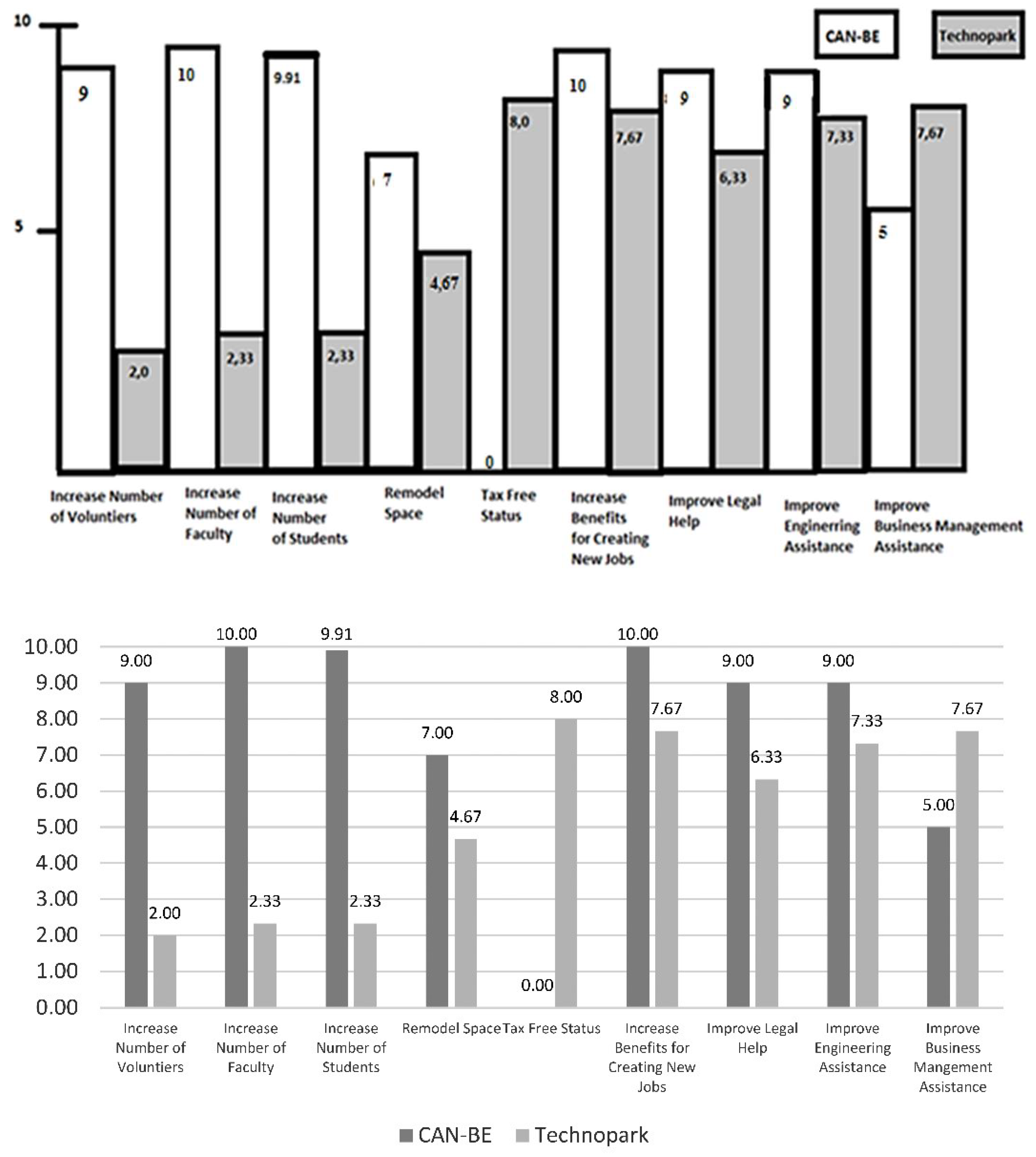
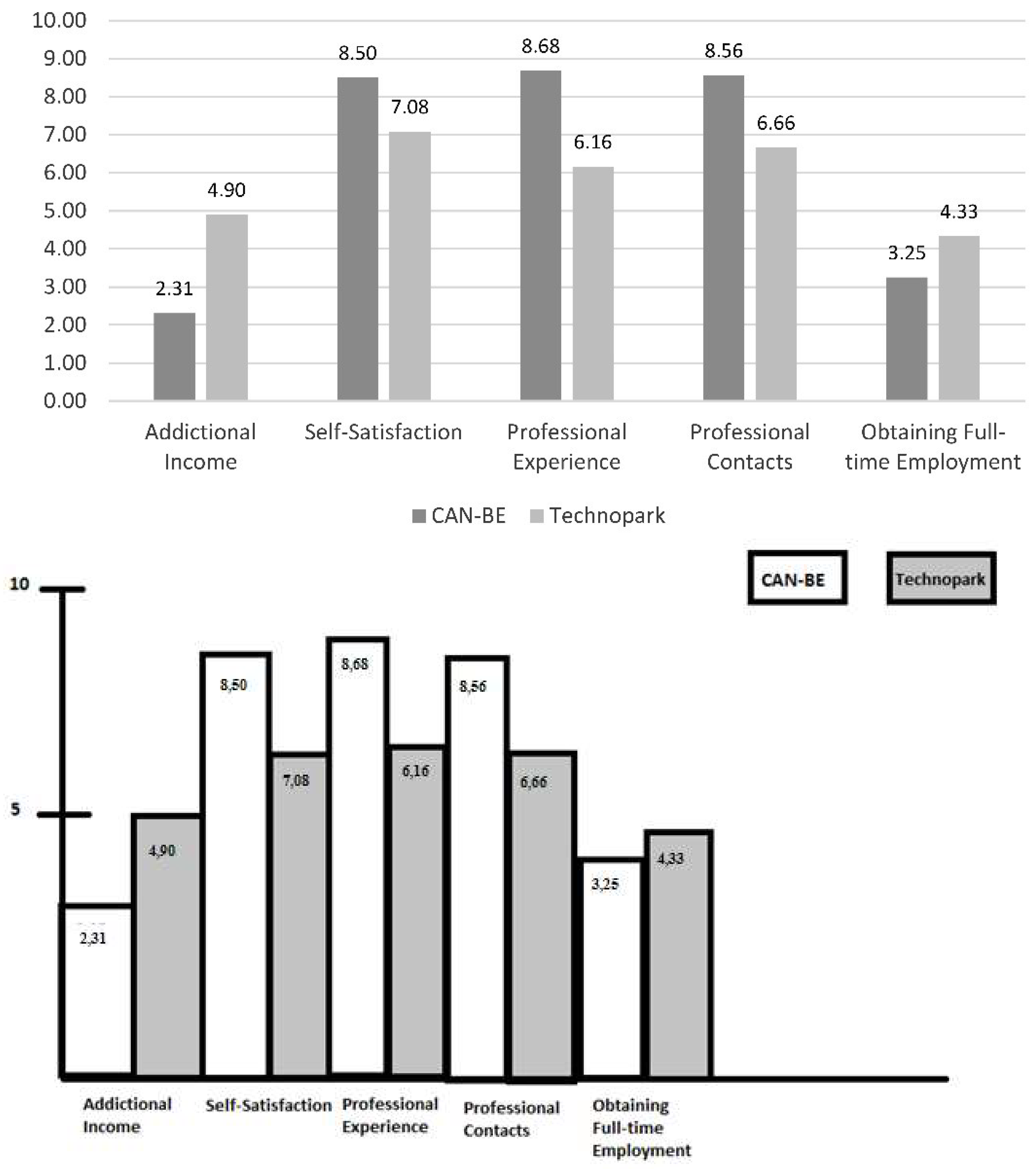
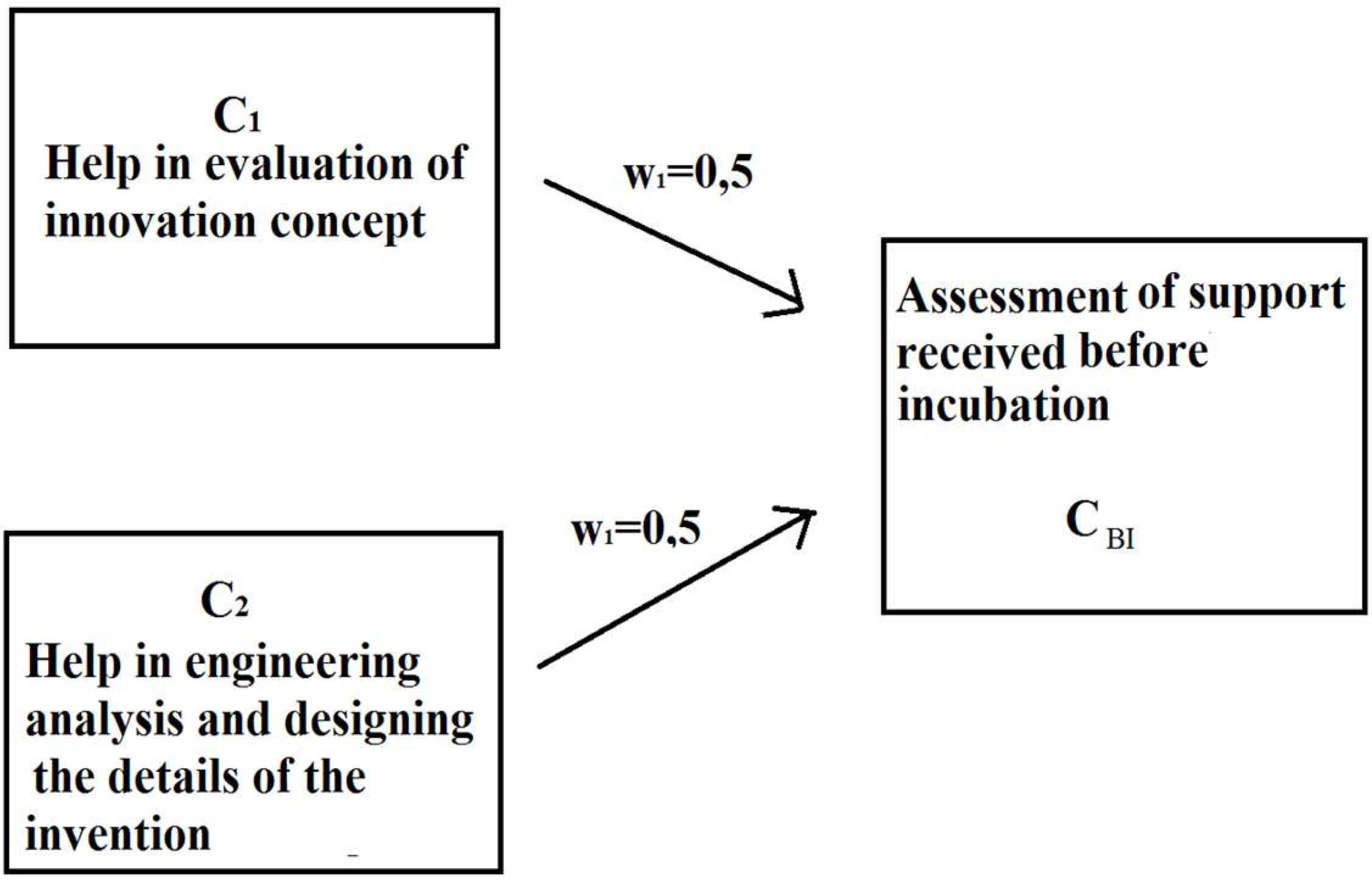
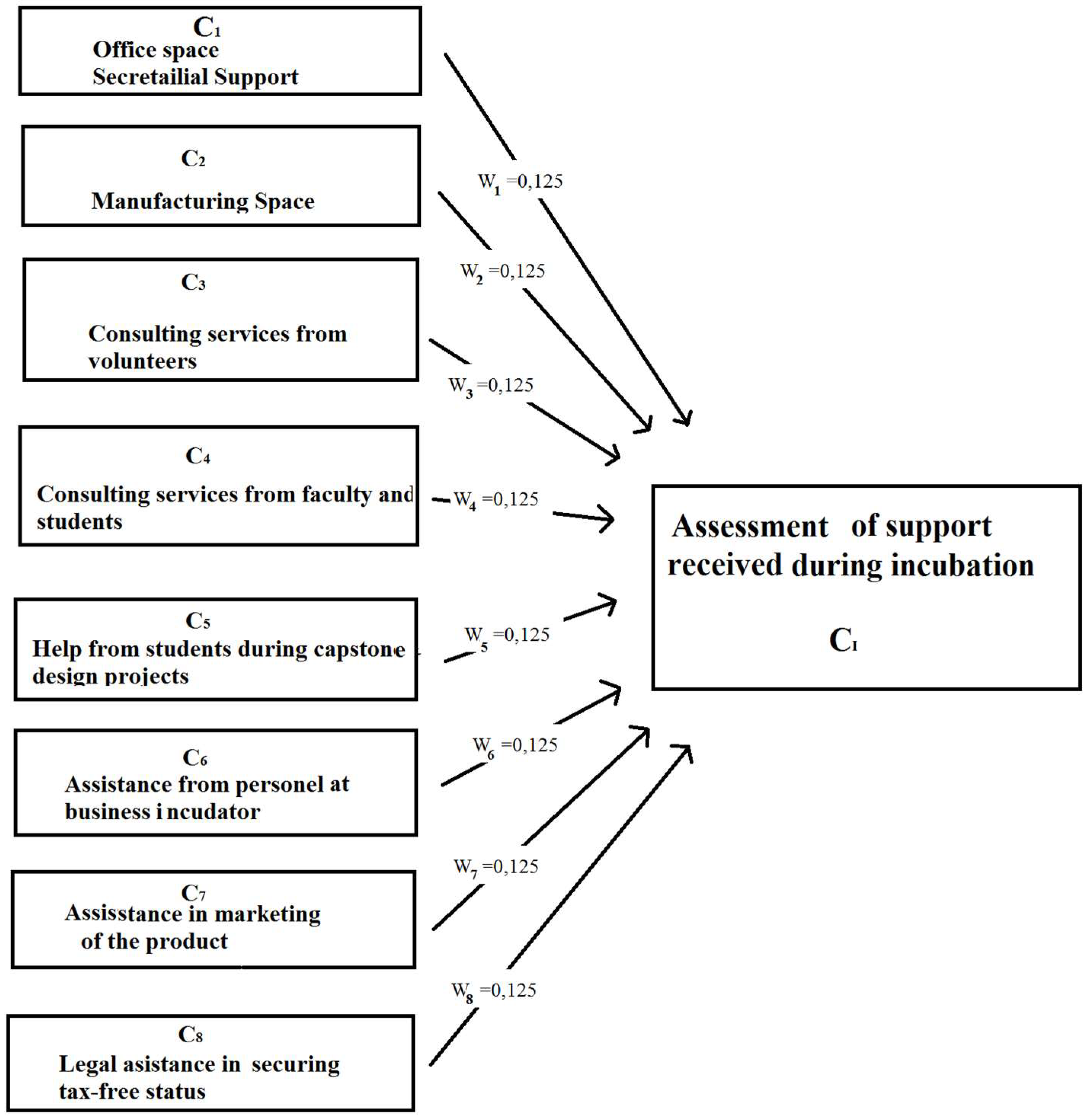
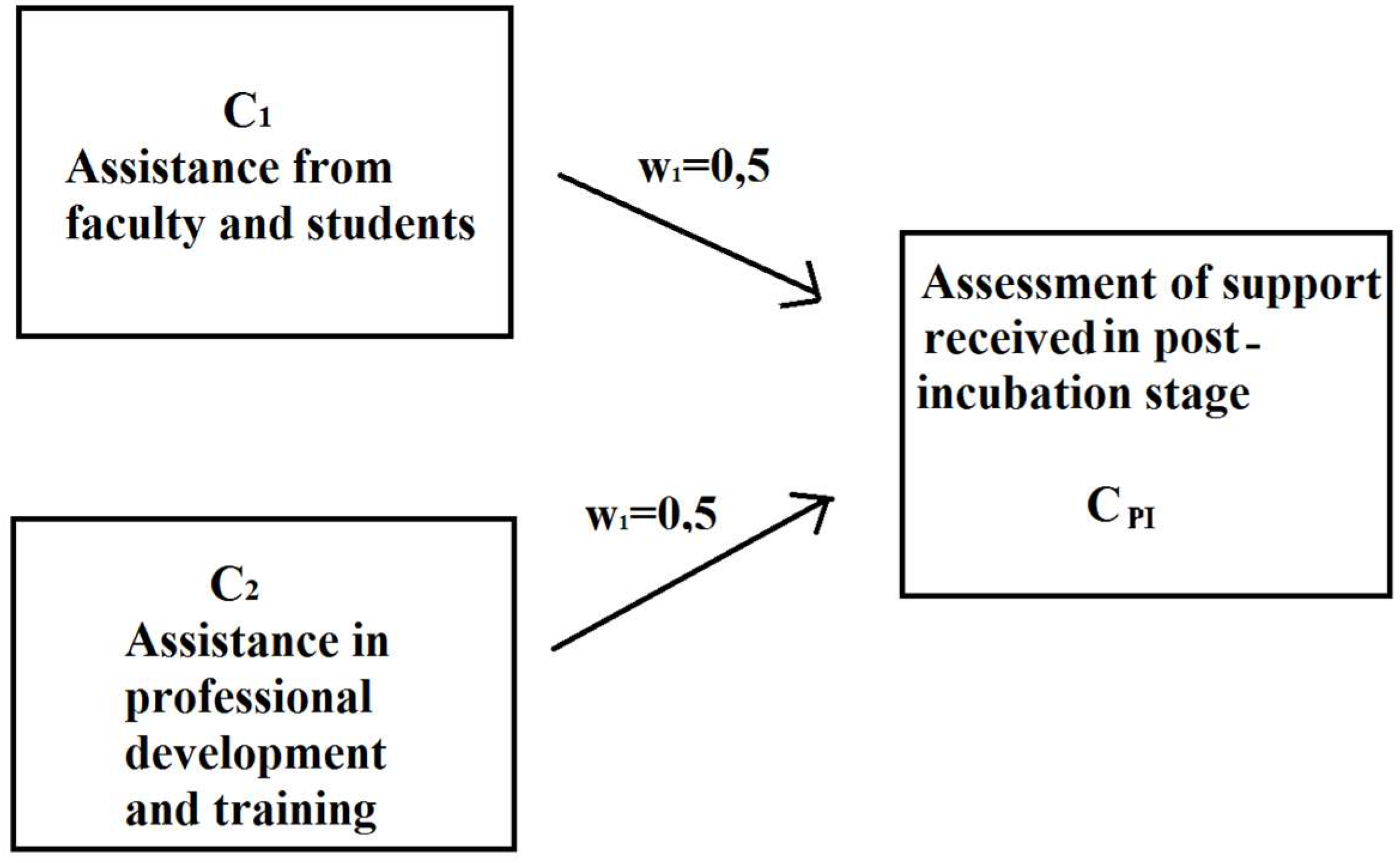
| Type of Support | N (Sample Size) | Mean Value | Standard Deviation | Significance (2-Tailed) | T-Test for Equality of Means | Standard Error Mean |
|---|---|---|---|---|---|---|
| Assistance provided by volunteer consultant | 12 1 | 5.00 | 1.651 | 0.000 | 7.30 | 0.476 |
| 6 2 | 0.00 | 0.000 | 0.000 | 10.48 | 0.000 | |
| Assistance from faculty and students as consultants | 12 | 9.50 | .674 | 0.001 | 10.12 | 0.194 |
| 6 | 1.66 | 2.581 | 0.001 | 7.30 | 1.054 | |
| Assistance from students doing a capstone design project for the company | 12 | 9.00 | 1.348 | 0.000 | 16.10 | 0.389 |
| 6 | 0.00 | 0.000 | 0.000 | 23.12 | 0.000 | |
| Legal assistance in securing tax-free status or tax advantages for new companies | 12 | 9.00 | 1.206 | 0.000 | 18.00 | 0.348 |
| 6 | 0.00 | 0.000 | 0.000 | 25.85 | 0.000 | |
| Legal assistance in applying for financial support for creating new jobs | 12 | 4.00 | 1.537 | 0.000 | 6.26 | 0.443 |
| 6 | 9.00 | 0.000 | 0.000 | 9.01 | 0.000 | |
| Assistance in professional development and training | 12 | 5.75 | 2.050 | 0.002 | 3.66 | 0.591 |
| 6 | 1.66 | 2.581 | 0.002 | 3.37 | 1.054 | |
| Assistance in developing marketing strategies or internet sales | 12 | 6.00 | 1.651 | 0.000 | 8.76 | 0.476 |
| 6 | 0.00 | 0.000 | 0.000 | 12.58 | 0.000 | |
| Legal assistance in protecting intellectual property (patent) | 12 | 8.50 | 1.381 | 0.000 | 14.83 | 0.398 |
| 6 | 0.00 | 0.000 | 0.000 | 21.31 | 0.000 | |
| Engineering assistance in improving innovation | 12 | 7.50 | 1.732 | 0.000 | 10.44 | 0.500 |
| 6 | 0.00 | 0.000 | 0.000 | 15.00 | 0.000 | |
| Assistance in establishing continuous quality improvement procedures. | 12 | 7.50 | 1.834 | 0.000 | 9.86 | 0.529 |
| 6 | 0.00 | 0.000 | 0.000 | 14.16 | 0.000 |
| Type of Support | N (Sample Size) | Mean Value | Standard Deviation | Significance (2-Tailed) | T-test for Equality of Means | Standard Error Mean |
|---|---|---|---|---|---|---|
| Increase the number of volunteers | 12 1 | 9.00 | 1.044 | 0.000 | 14.00 | 0.301 |
| 6 2 | 2.00 | 0.894 | 0.000 | 14.782 | 0.365 | |
| Increase the number of faculty assisting the company | 12 | 10.00 | 0.000 | 0.000 | 26.55 | 0.000 |
| 6 | 2.33 | 1.032 | 0.000 | 18.18 | 0.421 | |
| Increase the number of students doing a capstone design project for the company | 12 | 9.91 | 0.288 | 0.000 | 12.86 | 0.083 |
| 6 | 2.33 | 2.33 | 0.000 | 8.94 | 0.843 | |
| Remodel office and manufacturing space | 12 | 7.00 | 1.758 | 0.058 | 2.04 | 0.507 |
| 6 | 4.66 | 3.141 | 0.058 | 1.69 | 1.282 | |
| Incorporate tax-free status for 10 years for new companies | 0 | N/A * | N/A * | N/A * | N/A * | N/A * |
| Increase the financial benefit for creating new jobs | 12 | 10.00 | 0.000 | 0.028 | 4.48 | 0.000 |
| 6 | 7.66 | 1.861 | 0.028 | 3.07 | 0.760 | |
| Improve legal help (intellectual properties, taxes) | 12 | 9.00 | 1.206 | 0.133 | 2.36 | 0.348 |
| 6 | 6.33 | 3.614 | 0.133 | 1.75 | 1.475 | |
| Increase engineering assistance (designing structural analysis, quality control) | 12 | 9.00 | 1.348 | .065 | 1.98 | 0.389 |
| 6 | 7.33 | 2.250 | 0.065 | 1.67 | 0.918 | |
| Increase help related to business management and accounting | 12 | 5.00 | 2.593 | 0.0261 | 2.23 | 0.748 |
| 6 | 7.66 | 1.861 | 0.0261 | 2.49 | 0.760 |
| Type of Benefits | N (Sample Size) | Mean Value | Standard Deviation | Significance (2-Tailed) | T-Test for Equality of Means | Standard Error Mean |
|---|---|---|---|---|---|---|
| Additional Income | 16 1 | 2.31 | 2.120 | 0.054 | 2.023 | 0.530 |
| 12 2 | 4.90 | 4.482 | 0.054 | 1.769 | 1.351 | |
| Self-satisfaction | 16 | 8.50 | 1.414 | 0.071 | 2.053 | 0.353 |
| 12 | 7.08 | 2.234 | 0.071 | 1.026 | 0.645 | |
| Gaining Professional Experience | 16 | 8.68 | 1.352 | 0.048 | 2.448 | 0.338 |
| 12 | 6.16 | 3.833 | 0.048 | 2.178 | 1.106 | |
| Establishing Professional Contacts | 16 | 8.56 | 1.209 | 0.045 | 2.105 | 0.302 |
| 12 | 6.66 | 3.339 | 0.045 | 1.877 | 0.964 | |
| Obtaining Full-time Employment in a Start-up Company | 16 | 3.25 | 1.183 | 0.058 | 2.095 | 0.295 |
| 12 | 4.33 | 1.557 | 0.058 | 2.013 | 0.449 |
© 2019 by the authors. Licensee MDPI, Basel, Switzerland. This article is an open access article distributed under the terms and conditions of the Creative Commons Attribution (CC BY) license (http://creativecommons.org/licenses/by/4.0/).
Share and Cite
Wolniak, R.; Grebski, M.E.; Skotnicka-Zasadzień, B. Comparative Analysis of the Level of Satisfaction with the Services Received at the Business Incubators (Hazleton, PA, USA and Gliwice, Poland). Sustainability 2019, 11, 2889. https://doi.org/10.3390/su11102889
Wolniak R, Grebski ME, Skotnicka-Zasadzień B. Comparative Analysis of the Level of Satisfaction with the Services Received at the Business Incubators (Hazleton, PA, USA and Gliwice, Poland). Sustainability. 2019; 11(10):2889. https://doi.org/10.3390/su11102889
Chicago/Turabian StyleWolniak, Radosław, Michalene Eva Grebski, and Bożena Skotnicka-Zasadzień. 2019. "Comparative Analysis of the Level of Satisfaction with the Services Received at the Business Incubators (Hazleton, PA, USA and Gliwice, Poland)" Sustainability 11, no. 10: 2889. https://doi.org/10.3390/su11102889
APA StyleWolniak, R., Grebski, M. E., & Skotnicka-Zasadzień, B. (2019). Comparative Analysis of the Level of Satisfaction with the Services Received at the Business Incubators (Hazleton, PA, USA and Gliwice, Poland). Sustainability, 11(10), 2889. https://doi.org/10.3390/su11102889






